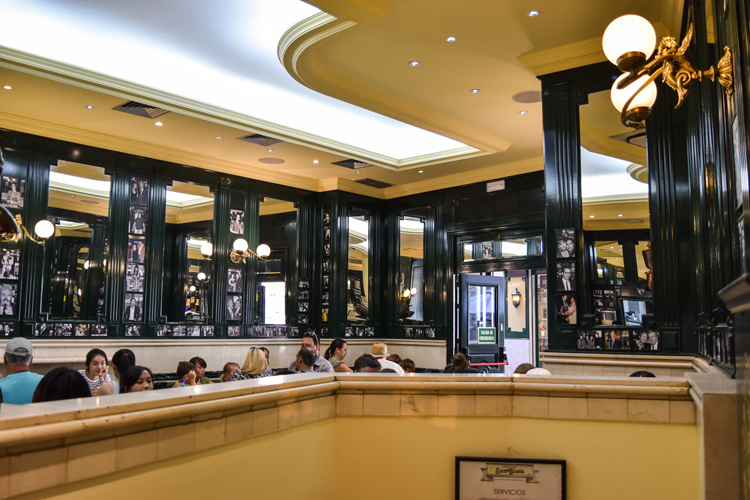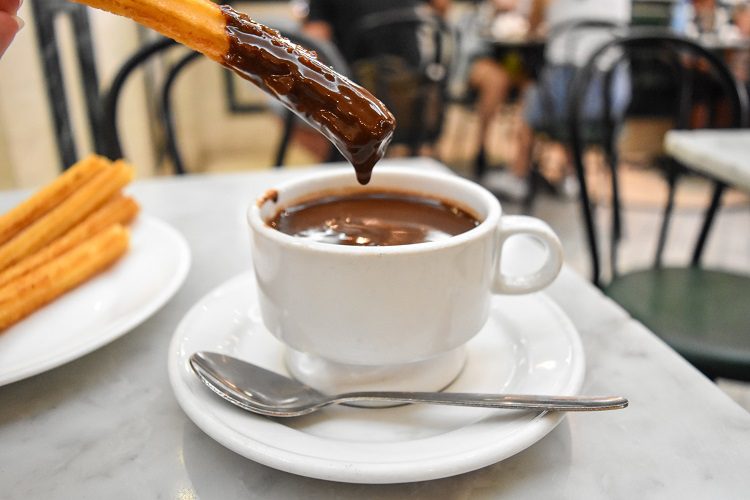To walk into a café in Spain is overwhelming with the smells of freshly baked goods. You can find apple turnovers, blueberry muffins, cinnamon rolls, and even French-style croissants. But the king/queen of them all is Spain’s traditional doughnut, the churro. Made with simple ingredients, this soft but chewy pastry is typically eaten for breakfast or after a late night out in town. Many churro shops operate throughout Spain, but the one steeped in tradition is the San Ginés Chocolatería located in Madrid. What makes this place so special? Keep reading to find out!

A freshly fried churro roll waits to be cut into sections and be served with rich hot chocolate | Cheyenne Trautman
There are many theories of where the churro originated, but there are two that are most popular. According to the Huffington Post, the first theory is that Spanish shepherds created this fluffy cake-like dessert to eat after a long day’s work. But a website dedicated to churros suggests that it was brought by the Portuguese while trading with China. The Chinese had their Youtiao, a fried flour stick, and the Portuguese were believed to have brought that idea to Spain but made into more of a sweet treat instead of a salty snack. Although no one knows for sure, that does not change the fact that churros today are typically found at local cafés and bars. This fried pastry is commonly served with a sprinkle of cinnamon and sugar, a cup of melted chocolate, or plain. However, at San Ginés Chocolatería, the chocolatiers continue the Spanish tradition of serving a rich cup of melted chocolate with their freshly fried churros. As I saw before my eyes, it goes something like this…

Green trim and marble accents create a cozy interior for the San Ginés Chocolatería | Cheyenne Trautman
A chocolatier at San Ginés squeezed out dough (flour, water, and salt) from a churrera, a syringe-like tool with a star-shaped nozzle, in a circular motion into the shallow fryer of sunflower oil. The spiraled mass began to swelter and turn golden. He monitored his masterpiece closely, making sure it did not burn. He waited patiently to flip over his creation with the metal spatula sitting calmly in his hand. A few more seconds passed by. Within minutes, sections of the perfectly blonde, crisp coil appeared on a ceramic dish before my watering taste buds. Hungry yet? Probably not quite, as the best part of San Ginés is yet to come.
Originally built in 1890, San Ginés started as an inn for travelers. Emerald trim and walls deeply contrast with the white marble flooring, making this place a cozy home away from home until 1894, when it was devoted entirely to chocolate. Drinking hot chocolate is nearly as ancient as the discovery of America. The Spruce website states that ancient Mayans and Aztecs were trading cocoa beans between one another way before the Spaniards came to the Americas. Mayans and Aztecs used chocolate mixed with chilies to make a spicy drink for religious ceremonies. When Hernan Cortez came to the New World, he tried the spicy drink and is given the credit for sending cocoa beans back to Spain in 1544. In the 16th century Madrid, chocolatiers would add cane sugar to the chocolate to make a much sweeter treat. They started selling this savory drink cold mornings for the locals who worked nights. Eventually, it became a habit to have hot chocolate before bed.

A chocolatier finishes frying a spiraled roll of churros | Cheyenne Trautman
Now when I am talking about hot chocolate, I am not talking about what you might typically think of as hot chocolate. Spanish hot chocolate is authentic chocolate melted down with no water added. Jack Meyers, from New Jersey, who was trying this, can tell the difference. “This is not like the hot chocolate from the United States with the powder you add to water, this [chocolate] is very rich.” Having tasted this decadent Spanish chocolate for myself, I completely agree with Jack. At a temperature that is not too hot nor too cold, the chocolate drink is at a perfect consistency for dunking and sipping. Its richness overwhelmed me as I am used to mediocre chocolates I snack on in America. I was curious to see if I could get a hint of how and why this chocolate was so special. Only to remain a mystery when waiter Pablo Sanchez mentions, “It’s like a secret recipe, I do not know what the ratio of cocoa and milk it has.” One thing known for sure is that this chocolate dip/drink has the locals and tourists swarming into the store’s narrow doorway wanting a plate of their famous churros con chocolate (churros with chocolate). Local custom says you must not eat the churros or chocolate solo. Churros con chocolate exists for an essential reason. The plain crispy churros would not do you justice without their chocolate dipping pool. The richness of the warm chocolate compliments and amplifies the simplicity of the crunchy pastry. Just like a plain doughnut with its chocolate overcoat, basic flavors meet elaborate flavors, creating an overall masterpiece. In sum, this place does not appear to slow down as the day wears on. The only time San Ginés gets a change of pace is during holidays and during the winter. But it does not get slower as you may think. “It gets more busy in winter and the holidays. Because of the colder temperature, more people come for the hot chocolate during the winter,” says Sanchez.

Churros Con Chocolate is San Gines’s specialty | Cheyenne Trautman
Churros con chocolate is, of course, not limited to San Ginés. By just walking around the city center, I have poked my head into three other bars (cafés) and found the same dish. At San Ginés however, you receive six fluffy, freshly fried churros and a cup of rich, melted chocolate for just four euros. A hard combination to beat! Whether you decide to order your own serving of churros con chocolate or share with a friend, this Spanish treat is worth trying. And if you have a bucket list for Madrid, San Ginés Chocolatería might be a sweet addition.
San Ginés Chocolateriá; Pasadizo San Ginés 5, 28013 Madrid, Spain. Closest metro is Sol. About a 5-minute walk from the metro station; +34 913 656 546; 24 hours everyday.
Cost: churros con chocolate—€4 ($4.66)
Travel Journalism, Photography & Video Internship Seminar in Madrid, Spain

